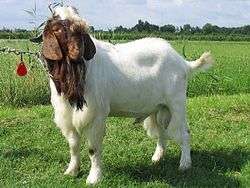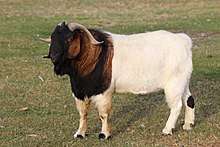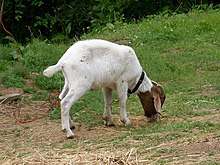Boer goat
The Boer goat is a breed of goat that was developed in South Africa in the early 1900s and is a popular breed for meat production. Their name is derived from the Afrikaans (Dutch) word boer, meaning farmer.




Boer Goat is mainly used for enhancing productivity and weight gain capacity of a less productive goat through crossbreeding. these breed has the potential to gain weight quickly compared to other breeds. At the age of 3 months Boer goat achieve 20 kg body weight.[1]
Origins and characteristics
The Boer goat was probably bred from the indigenous South African goats kept by the Namaqua, San, and Fooku tribes, with some crossing of Indian and European bloodlines being possible. They were selected for meat rather than milk production; due to selective breeding and improvement, the Boer goat has a fast growth rate and excellent carcass qualities, making it one of the most popular breeds of meat goat in the world. Boer goats have a high resistance to disease and adapt well to hot, dry semideserts. United States production is centered in west-central Texas, particularly in and around San Angelo and Menard. The original US breeding stock came from herds located in New Zealand. Only later were they imported directly from Africa
Boer goats commonly have white bodies and distinctive brown heads. Some Boer goats can be completely brown or white or paint, which means large spots of a different color are on their bodies. Like the Nubian goat, they possess long, pendulous ears. They are noted for being docile, fast-growing, and having high fertility rates. Does are reported to have superior mothering skills as compared to other breeds. Boer goats tend to gain weight at about the same rate as their sire, so a buck from a proven fast-growing bloodline will command the highest price, as its offspring tend to also be fast growers. The primary market for slaughter goats is a 22–36 kg (49–79 lb) kid; kids should reach marketable size at weaning age. The kid of a proven fast-growing sire might weigh 36 kg (79 lb) at 90 days, while the kid of a poor-quality sire might weigh only 15 kg (33 lb) at 90 days. An average-quality buck will initially be less expensive to purchase, but it can significantly undermine an operation's long-term profitability.
Due to their versatility on different terrains, Boer goat are frequently used for land maintenance, especially to prevent bush encroachment on rangeland. As typical browsers, the goats are able to suppress re-growth after bush thinning and to browse from plants up to 1.8 meters high, standings on their hind legs.
Doe
A doe used to breed show-quality goats are normally very large. For commercial meat production, medium-sized does are normally preferred, as they produce the same number of kids, but require less feed to do so. As a general rule, the more kids born per doe, the greater profit margins for the owner. Boer goats are polyestrous (they can breed throughout the year), and they reach sexual maturity at five months of age. A typical breeding program is to produce three kid crops every two years, meaning the does are pregnant for five months, nurse their kids for three months, and then are rebred. Multiple births are common, and a 200% kid crop is achievable in managed herds. Usually, first-time does have one kid, but they may have more. After that, they usually have two kids every other breeding. The kids can be brown, black, white, or mixed.
Crossbreeding
While purebred bucks are usually preferred for breeding purposes, crossbred does are commonly used for kid production, with the resulting offspring being 7/8 or more Boer. Common crosses are Boer x Spanish goat, Boer x Angora goat, Boer x Kiko goat, Boer x Nubian goat, Boer x Sirohi, Boer x Osmanabadi, and Boer x Jamnapari goat. An effort to crossbreed with the Malabari goat has been controversial.[2]
Percentage Boer goats are very common in commercial meat herds, and with those just starting out in the Boer goat business due to ease of acquisition and affordability. Over time, percentage animals can be bred up to American purebred status. An American purebred is a Boer goat of 15/16ths Boer blood (F4) for does and 31/32nds blood (F5) for Boer bucks. Bucks must be one generation of Boer breeding higher than does to achieve this status because they have the potential to spread their genetic pool much further than any single doe; a higher level of Boer blood lessens the chances of other breed qualities in the offspring. Although American purebreds can never be registered as Fullblood (FB), many breeders still use a good American purebred buck with excellent results.
Many producers still prefer purebred or fullblood bucks and does, and intentional crossbreeding is far from universal.
Note: The 'F' designation is the commonly used shorthand for indicating the percentage of pure blood (Boer in this case) resulting from crossbreeding of a Pureblood boer buck with does of other breeds:
- F1 : 1/2 boer blood (Pureblood buck sire, other breed doe)
- F2 : 3/4 boer blood (Pureblood buck sire, F1 doe)
- F3 : 7/8 boer blood (Pureblood buck sire, F2 doe)
- F4 : 15/16 boer blood (Pureblood buck sire, F3 doe)
- F5 : 31/32 boer blood (Pureblood buck sire, F4 doe)
Show goats
Although Boer goats raised specifically for show purposes may seem to have little in common with pastured commercial goats, the difference is superficial. They are bred to be larger than normal goats, and meet specific visual appearances, but these very characteristics are valuable genes to add to the commercial herd. Boer goats were originally imported into the US and other countries for this very reason. Their value to ranchers lies in the improvement the addition of their unique genes can offer any breed of goats being raised for meat. Few producers could afford to maintain a herd of essentially useless animals. Show goats are bred to represent the most desirable characteristics of the Boer goat, and their main purpose is to introduce these animals to the public. It is also a method of recognizing the best of the best, although some really superior goats are not shown preference. Bucks and does bred for show can be and often are used for commercial breeding stock.[3] To show, most Boer goats have to be registered with either the CMGA, ABGA, IBGA, or USBGA. Though Boer goats are often bred to be shown, they can also make very good pets.
References
- "Boer goat".
- "The Hindu : `Malabari' goats under threat of extinction". www.thehindu.com. Retrieved 2018-08-29.
- Bowman, Gail, Raising Meat Goats for Profit 0967038103
External links
| Wikimedia Commons has media related to Boer goat. |